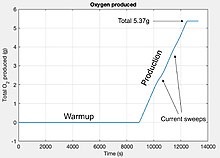Mars Oxygen ISRU Experiment
[5] MIP was intended to demonstrate In-Situ Propellant Production (ISPP) on a laboratory scale using electrolysis of carbon dioxide to produce oxygen.Through a combination of thermal dissociation and electrocatalysis, an oxygen atom is liberated from the CO2 molecule and picks up two electrons from the cathode to become an oxide ion (O2–).Inert gases such as nitrogen gas (N2) and argon (Ar) are not separated from the feed, but returned to the atmosphere with the carbon monoxide (CO) and unused CO2.[4] On April 21, 2021, Jim Reuter, the Associate Administrator for STMD explained that the experiment was functioning with results having many uses, stating: "This is a critical first step at converting carbon dioxide to oxygen on Mars.MOXIE has more work to do, but the results from this technology demonstration are full of promise as we move toward our goal of one day seeing humans on Mars.MOXIE successfully completed all of its technical requirements and was operated at a variety of conditions throughout a full Mars year, allowing the instrument’s developers to learn a great deal about the technology.[16] NASA states that if MOXIE worked efficiently, they could land an approximately 200-times larger, MOXIE-based instrument on the planet, along with a power plant capable of generating 25–30 kilowatts (34–40 hp).

Moxie (disambiguation)Jet Propulsion LaboratoryWebsitePerseverancetechnology demonstrationMars 2020oxygencarbon dioxideMartian atmospheresolid oxide electrolysisnatural resourcehuman missionoxidizerpropellanthydrogenMassachusetts Institute of TechnologyHaystack ObservatoryCaltechdust stormMars Surveyor 2001 LanderMars Surveyor 2001Mars Polar LanderMichael HechtJeffrey HoffmanCeramatec, Inc.Air SquaredImperial College LondonNiels Bohr InstituteUniversity of CopenhagenArizona State UniversityTechnical University of DenmarkMartian atmosphericHEPA filterscroll compressorcarbon monoxideyttria-stabilized zirconiaconductorselectrodescathodeInert gasesnitrogen gasJezero Crateramperemethanesample return missionPerovskiteCermetBibcodeNational Aeronautics and Space AdministrationWayback MachineThe RegisterSpace.comTimeline of Mars 2020Perseverance roverIngenuity helicopterlist of flightsHazcamMastcam-ZNavcamRIMFAXRover embedded computersSHERLOCSuperCamMarsDialMulti-mission radioisotope thermoelectric generatorRocker-bogieSky craneColumbia HillsGusev craterSyrtis Major PlanumEberswalde craterHolden craterMawrth VallisNili FossaeMelas ChasmaOctavia E. Butler LandingCheyava FallsExploration of MarsOutline of MarsGeographyAtmosphereCirculationClimateDust devil tracksRegionsArabia TerraCerberus (Mars)CydoniaEridania LakeIani ChaosOlympia UndaePlanum AustralePlanum BoreumQuadranglesSinus MeridianiTempe TerraTerra CimmeriaTerra SabaeaTharsisVastitas BorealisPhysicalfeatures"Canals"CatenaeChaos terrainCratersFossaeGulliesMensaeMountainsby heightObserved rocksOutflow channelsPlainsValley networkValleysGravityGeologyBrain terrainCarbonatesCompositionConcentric crater fillDark slope streakDichotomyFretted terrainGeysersGlaciers